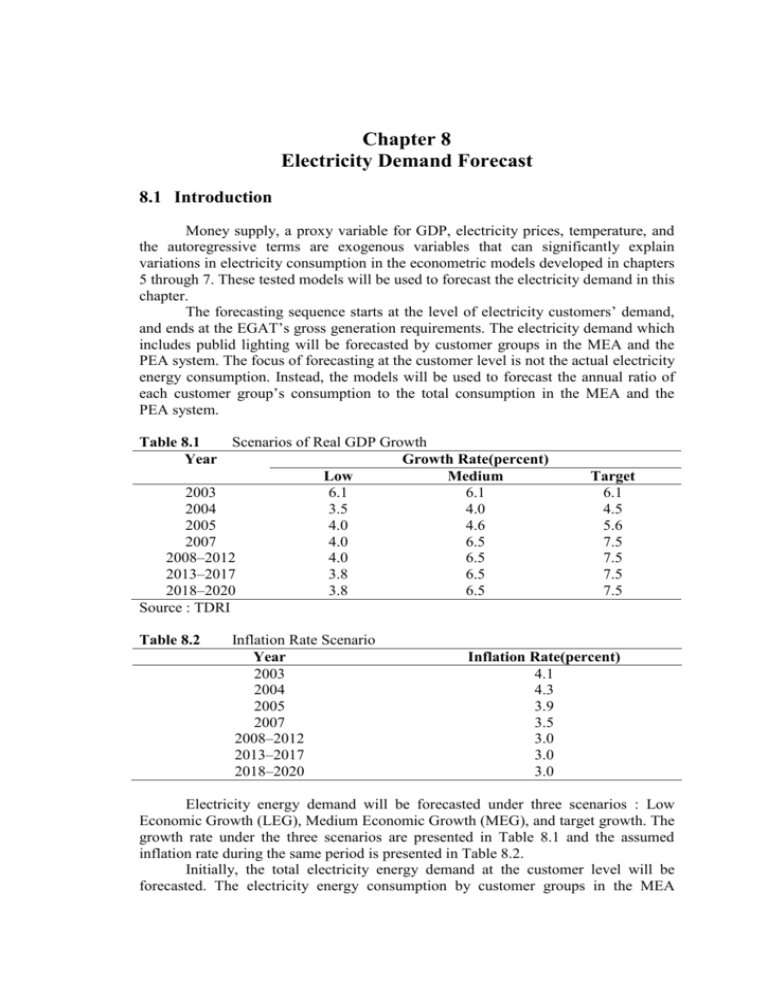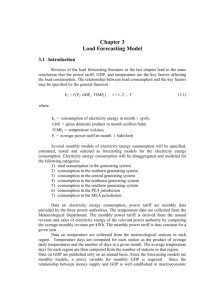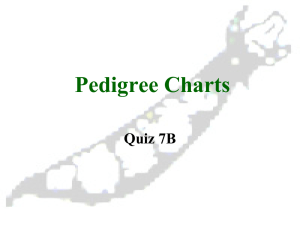Electricity Demand Forecast
advertisement

Chapter 8 Electricity Demand Forecast 8.1 Introduction Money supply, a proxy variable for GDP, electricity prices, temperature, and the autoregressive terms are exogenous variables that can significantly explain variations in electricity consumption in the econometric models developed in chapters 5 through 7. These tested models will be used to forecast the electricity demand in this chapter. The forecasting sequence starts at the level of electricity customers’ demand, and ends at the EGAT’s gross generation requirements. The electricity demand which includes publid lighting will be forecasted by customer groups in the MEA and the PEA system. The focus of forecasting at the customer level is not the actual electricity energy consumption. Instead, the models will be used to forecast the annual ratio of each customer group’s consumption to the total consumption in the MEA and the PEA system. Table 8.1 Scenarios of Real GDP Growth Year Growth Rate(percent) Low Medium 2003 6.1 6.1 2004 3.5 4.0 2005 4.0 4.6 2007 4.0 6.5 2008–2012 4.0 6.5 2013–2017 3.8 6.5 2018–2020 3.8 6.5 Source : TDRI Table 8.2 Inflation Rate Scenario Year 2003 2004 2005 2007 2008–2012 2013–2017 2018–2020 Target 6.1 4.5 5.6 7.5 7.5 7.5 7.5 Inflation Rate(percent) 4.1 4.3 3.9 3.5 3.0 3.0 3.0 Electricity energy demand will be forecasted under three scenarios : Low Economic Growth (LEG), Medium Economic Growth (MEG), and target growth. The growth rate under the three scenarios are presented in Table 8.1 and the assumed inflation rate during the same period is presented in Table 8.2. Initially, the total electricity energy demand at the customer level will be forecasted. The electricity energy consumption by customer groups in the MEA 109 system and in each region of the PEA system are then forecasted. The MEA and PEA forecast are then linked to the forecast of gross generation requirements in the EGAT system. Finally, peak demand will be forecasted by the econometric models and by the load profile patterns. 8.2 Forecast of Total Electricity Energy Demand The annual forecast of electricity energy consumption may be computed from the monthly forecast by 12 r r Eijk = Eitk j = 1, 2, 3, ... (8.1) m=1 where r Eijk = electricity energy consumption of the i customer group in the r system in year j under the k growth rate scenario r Eitk = electricity energy demand of the i customer group in the r system in month t under the k growth rate scenario t = j 1 *12 + m m = 1, 2, ..., 12 j = 1, 2, ... (8.2) The i customer group energy share under the k growth rate scenarios is the ratio of the i customer group’s electricity energy consumption to the total electricity energy consumption in year j in the r system under the same scenario and is computed by r fijk = r Eijk (8.3) r Eijk i The total electricity energy consumption in the r distribution system in year j under the k growth rate scenario, E rjk , is obtained from 12 E rjk = E rtk j = 1, 2, ... (8.4) m=1 where t is defined by (8.2) Electricity energy consumption of the i customer group in the r distribution system in year j under the k growth rate scenario is then forecasted by r r Eijk = fijk * E rjk (8.5) 110 Allowing for the energy losses, Lrj , in the distribution system, the required electricity energy for the r distribution system in year j may be forecasted by RE rjk = E rjk 1L r j 100 (8.6) Since energy losses in the distribution system may be controlled to a certain extent, a 3.64 percent loss is set for the MEA system and a 5.20 percent loss is set for the PEA system. The loss figures are based on the average losses in the MEA and PEA systems between 2002 and 2004. The underlying assumption is that the future losses will not exceed past losses in either system. The MEA’s electricity energy demands are purchased entirely from EGAT as indicated by the expression PE MEA = RE MEA jk jk (8.7) In contrast, the PEA generated a small amount of electricity energy to supplement its electricity energy purchase from EGAT. The amount of PEA’s electricity energy purchase and its own generation between 2002 and 2004 is presented below Year Units Purchased (GWh) 2002–2004 Proportion 580,492.378 0.999262 Own Generation and Other Purchase (GWh) 428.640 0.000738 The ratio of electricity energy purchased from EGAT, indicated by a, to the total electricity energy demand required in the PEA system is set at 0.999262. The electricity energy purchased from EGAT in year j under the k growth rate scenario is thus expressed by PE PEA = a*RE PEA jk jk (8.8) The electricity energy forecasting sequences for the MEA and PEA systems are presented in Figure 8.1 and Figure 8.2, respectively. The total energy requirement from the EGAT system to satisfy the MEA and PEA demand may be expressed by E EGAT = PE MEA + PE PEA + PE DC jk jk jk j (8.9) where PE DC is the electricity energy sales to EGAT’s direct customers in year j j Allowing for station uses and losses in the EGAT system of LEGAT percent, the j electricity energy requirement from EGAT in year j under the k growth rate scenario which may be met by EGAT’s own generation, purchases from the IPP and from foreign sources, may be expressed by 111 RE EGAT = E EGAT jk jk 1L EGAT j 100 (8.10) MEA energy demand in year j PE MEA = RE MEA j j MEA energy consumption in year j E MEA j = i=1 MEA energy loss in year j EijMEA LMEA j (Econometric model) Energy consumption by MEA customer groups including street lighting EijMEA (Energy share from econometric model) Figure 8.1 Forecasting Sequences in the MEA System EGAT energy sales to PEA in year j PE PEA j PEA energy generation PEA energy demand in year j RE PEA j PEA energy consumption in year j E PEA j (Econometric model) PEA energy loss in year j LPEA j Energy consumption by PEA customer groups including street lighting EijPEA (Energy share from econometric model) Figure 8.2 Forecasting Sequences in the Total PEA System 112 Losses in the EGAT transmission system is recorded at 5.10 percent in 2003. This figure will be used in the forecasting model under the assumption that the future losses will not exceed this level. Figure 8.3 presents the forecasting sequences in the EGAT system. EGAT energy demand in year j RE EGAT j EGAT energy sales in year j EGAT energy loss in year j E jEGAT LEGAT j EGAT energy sales to MEA in year j PE MEA = RE MEA j j EGAT energy sales to PEA in year j PEjPEA EGAT energy sales to direct customer in year j PE DC j Figure 8.3 Forecasting Sequences in the EGAT System 8.3 Forecast of EGAT’s Electricity Energy Requirements by Regions The econometric models developed in chapter 4 to forecast EGAT’s electricity energy sales by regions are used to estimate the ratio of each region’s electricity energy sales to the total energy sales by q EGAT_f jk = EGAT_Eqjk q EGAT_E jk (8.11) q The computed ratio is then used to forecast the electricity energy sales of region q in year j under the k k growth rate scenario by q EGAT_E qjk = EGAT_f jk * E EGAT jk where E EGAT is obtained from (8.9) jk Electricity energy losses in the region q system is estimated from losses in the total EGAT system which may be expressed by LEGAT *RE EGAT 100 j jk (8.12) Electricity energy losses in the region q system is then computed from EGAT_Lqjk = EGAT_Lf q * LEGAT *RE EGAT 100 j jk (8.13) 113 where EGAT_Lf q is the ratio of electricity energy losses in region q to the total system losses between 2002 and 2004(see Table 8.3). This ratio is assumed to be constant throughout the forecasting period. Allowing for losses in the transmission system, the electricity energy requirement from the EGAT system for region q in year j under the k growth rate scenario may be estimated from EGAT_RE qjk = EGAT_E qjk + EGAT_Lqjk (8.14) The forecasting sequence of electricity energy requirement from EGAT by regions is presented in Figure 8.4 EGAT energy sales in year j E EGAT j EGAT energy sales in central region in year j EGAT energy sales in north region in year j EGAT energy sales in northeast region in year j EGAT_E Cj EGAT_E Nj EGAT_E NE j EGAT energy loss in central region in year j EGAT energy loss in north region in year j EGAT_LCj EGAT_LNj EGAT energy demand in central region in year j EGAT energy demand in north region in year j EGAT_RE Nj EGAT_RE Cj EGAT energy sales in south region in year j EGAT_ESj EGAT energy loss in northeast region in year j EGAT energy loss in south region in year j EGAT_LSj EGAT_LNE j EGAT energy demand in northeast region in year j EGAT energy demand in south region in year j EGAT_RESj EGAT_RE NE j Figure 8.4 Forecasting Sequences by Regions in the EGAT System Table 8.3 Year 2543 2544 2545 Total Proportion Losses in EGAT System by Regions (GWH) Central 935.9795 952.2188 1040.2572 2928.4554 0.4097 Losses in EGAT’s System Northeast North 352.0301 738.9166 304.2259 748.0052 340.2004 750.0269 996.4563 2236.9487 0.1394 0.3130 South 268.4409 341.2693 376.0052 985.7154 0.1379 Total 2295.3671 2345.7192 2506.4896 7147.5759 1.0000 Energy consumption in each region of the PEA system is forecasted within the same framework by linking the sum of electricity energy consumption of the i customer group in each regions to the group’s total consumption. The link is established by computing the ratio of electricity energy consumption of the i customer group in region q to the group’s total electricity energy consumption from 114 q PEA_fijk = q PEA_Eijk q PEA_Eijk (8.15) q q where PEA_Eijk is the forecast of electricity energy consumption of the i customer group in region q in year j under the k growth rate scenario from the models developed in chapter 5. Electricity energy consumption of the i customer group in region q under the k growth rate scenario is then forecasted by q q PEA PEA_Eijk = PEA_fijk * E ijk (8.16) PEA where Eijk is computed from (8.5) The electricity energy consumption in region q is simply the sum of each customer group’ consumption, i.e., q PEA_Eqjk = PEA_Eijk (8.17) i Losses in region q in the PEA system in year j under the k growth rate scenario, PEA_Lqjk , may be computed from PEA PEA_Lqjk = PEA_Lf q *LPEA 100 j *RE jk (8.18) where PEA_Lf q is the losses in region q estimated from the losses data between 2001 and 2003 in Table 8.4. Allowing for losses in its distribution system, the amount of electricity energy that PEA must purchase and generate in order to satisfy its customers in region q in year j under the k growth rate scenario is then PEA_RE qjk = PEA_Eqjk + PEA_Lqjk (8.19) The forecasting sequence of electricity energy consumption in the PEA system by regions is presented in Figure 8.5 Table 8.4 Year Losses in the PEA System by Regions (GWh) Energy Losses in Distributed System Central North Northeast 2544 1,694 950 995 2545 1,824 990 1,043 2546 1,999 1,174 1,236 Total 5,516 3,115 3,274 Proportion 0.3671 0.2073 0.2179 South 932 1,000 1,188 3,120 0.2077 115 PEA energy consumption by customer groups in year j including street lighting EijPEA ; i = 1, 2, PEA energy consumption by region q are by customer group i in year j PEA_Eijq (Energy share from econometric model) PEA energy consumption in region q in year j PEA_E qj = PEA_Eijq i PEA energy demand in region q in year j PEA energy loss in region q in year j PEA_RE qj PEA_Lqj Figure 8.5 Forecasting Sequences by Regions in the PEA System 8.4 Forecast of Total Electricity Energy Consumption The total electricity energy requirement in the kingdom is the sum of EGAT’s gross generation, purchases from the IPPs and SPPs, from foreign sources, and from PE PEA PEA’s own generation or RE PEA . The flow of electricity energy requirements j j is presented in Figure 8.6 Total electricity energy demand EGAT’s gross generation and purchase from SPP, IPP in year j RE EGAT j PEA’s own generation Energy purchased from sources outside EGAT system Table 8.6 Forecasting Sequences of Total Electricity energy Requirement 116 8.5 Forecast of Peak Demand Peak demand will be forecasted from the load factor computed from econometric models. For comparison purpose, the peak demand will also be forecasted from the customers’ load profile. 8.5.1 Forecast from Econometric Model EGAT Forecast of the electricity energy consumption and peak demand from the econometric models are used to compute the system load factor from the relationship EGAT EGAT LFjk = RE jk *100 (8.20) EGAT D jk *8760 where EGAT = EGAT’s gross energy generation and purchase from SPP and IPP in year j under the k growth rate scenario forecasted by models developed in chapter 4 RE jk EGAT = Forecast of EGAT system peak demand in year j under the k growth rate scenario from econometric models developed in chapter 6 D jk The system peak demand is forecasted from the system load factor in (8.20), EGAT energy demand, RE EGAT as forecasted by (8.10) in year j under the k jk growth rate scenario. EGAT LFjk , DEGAT jk LEGAT j = RE EGAT jk The power losses in EGAT’s system may be computed from the energy losses and the load factor LFjkEGAT by the relationship PDLEGAT = jk where (8.21) EGAT LFjk *8760 100 EGAT EGAT LFjk *L j (8.22) LSEGAT jk EGAT EGAT LSEGAT = 0.3LFjk + 0.7 LFjk jk 2 (8.23) The maximum power that EGAT sells to the MEA, the PEA, and direct customers in year j under the k growth rate scenario may be expressed by PDEGAT = DEGAT * 1 PDLEGAT 100 jk jk j (8.24) 117 The peak demand forecasting sequence in the EGAT system is presented in Figure 8.7 EGAT peak demand in EGAT’s system in year j D EGAT j (Econometric model) EGAT electricity energy demand in year j RE EGAT j (Econometric model) EGAT load factor in year j LFjEGAT Peak at purchase point IPP’s energy sales to customers outside the EGAT system in year j EGAT peak demand in EGAT’s system in year j EGAT electricity energy demand in year RE EGAT j D EGAT j Peak at load point Peak demand of customers outside EGAT’s system in year j Dj Thailand peak demand in year j EGAT peak demand power consumption in year j PD EGAT j DTHAI j + PEA large general service customers’ load factor EGAT peak power loss in year j Figure 8.7 Forecasting Sequences of Peak Demand in EGAT’s System by Econometric Models The peak power demand by regions in the EGAT system is forecasted in similar manners to the kingdom forecast. The forecast of electricity energy and peak demand by region in the EGAT system are used to compute the regional load factor. The load factor and electricity energy sales in region q are then used to forecast the region’s peak demand from q q EGAT_LFjk = EGAT_Dqjk = EGAT_RE jk *100 q EGAT_D jk *8760 EGAT_REqjk *100 q EGAT_LFjk *8760 (8.25) (8.26) where q EGAT_RE jk is the electricity energy consumption in region q in year j under the k growth rate scenario forecasted by econometric models 118 q EGAT_D jk is the peak demand in region q in year j under the k growth rate scenario forecasted by econometric models q EGAT_LFjk is the load factor at EGAT’s input point in region q in year j under the k growth rate scenario EGAT_RE qjk is the electricity energy demand in region q in year j under the k growth rate scenario computed from (8.14) EGAT_Dqjk is the forecast of peak demand at the input point in region q in year j under the k growth rate scenario MEA Peak demand at the MEA purchase point is forecasted both from the econometric models and from the customers’ load profiles. As in the case of EGAT, the system load factor at the purchase point in year j under the k growth rate scenario is estimated from MEA MEA LFjk RE jk = *100 MEA D jk *8760 (8.27) where MEA is the electricity energy required by the MEA system in year j under the k growth rate scenario forecasted from the econometric models in chapter 4 RE jk MEA is the peak demand in the MEA system in year j under the k growth rate scenario forecasted from the econometric models in chapter 6 D jk Peak demand in the MEA system in year j under the k growth rate scenario is then forecasted by PDMEA jk = RE MEA jk MEA LFjk *8760 100 (8.28) where RE MEA is the MEA peak demand at the input point computed from (8.6) jk Power losse in the MEA distribution system, PDLMEA jk , may be computed by PDLMEA jk where = MEA LFjk *LMEA j LSMEA jk (8.29) 119 MEA MEA LSMEA = 0.3LFjk + 0.7 LFjk jk 2 (8.30) Allowing for power losse in the distribution system, the MEA peak demand at the customer level is computed by MEA DMEA = PDMEA 100 jk jk * 1 PDL jk (8.31) PEA Peak demand in the PEA’s distribution system is forecasted in similar manners to the EGAT peak demand forecast. The system load factor at the purchase point in year j under the k growth rate scenario is estimated from PEA PEA LFjk RE jk *100 = (8.32) PEA D jk *8760 and the peak demand is estimated from PDPEA jk = RE PEA jk (8.33) PEA LFjk *8760 100 where PEA is the electricity energy at the purchase point in year j under the k growth rate scenario forecasted from the econometric models in chapter 4 RE jk PEA is the peak demand at the input point in year j under the k growth rate scenario forecasted from the econometric models in chapter 6 RE PEA jk is the electricity energy at the input point in year j under the k growth rate scenario estimated from (8.6) D jk Peak demand at the customer level in year j under the k growth rate scenario is then forecasted by PEA DPEA = PDPEA 100 jk jk * 1 PDL jk PEA PEA LFjk *L j where PDLPEA jk and PEA PEA LSPEA = 0.3LFjk + 0.7 LFjk jk = (8.34) (8.35) LSPEA jk 2 (8.36) The load factor and peak demand at the purchase point in region q in year j under the k growth rate scenario may be estimated in similar manners by 120 q q PEA_LFjk = PEA_RE jk *100 q (8.37) PEA_D jk *8760 PEA_PDqjk and = PEA_REqjk *100 q PEA_LFjk *8760 (8.38) where q PEA_RE jk is the electricity energy consumption at the input point for region q in year j under the k growth rate scenario as forecasted from the econometric models in chapter 4 q PEA_D jk is the peak demand at the customer level in region q in year j under the k growth rate scenario as forecasted by the econometric models in chapter 6 PEA_RE qjk is the electricity energy at the input point in region q in year j under the k growth rate scenario as estimated from (8.19) 8.5.2 Peak Demand Forecast from Customers’ Load Profile An accurate picture of the customers’ load profile is dependent on the sampling method. A power consumption recorder must be installed at selected customers’ purchase point to record his or her consumption pattern for a minimum period of 1 week. The recorder output will yield information on variations of consumption during a given day and also variations between days. However, the sampling of customers for recorder installation is not in the framework of this study. The load patterns used to forecast the peak demand are based on the available data collected by the two distribution utilities. The forecast of peak demand from the load profile may thus be considered as a demonstration of the forecasting technique. The MEA customers’ electricity energy consumption patterns are recorded at a 15 minute interval for 24 hours on a given day. In order to have a complete coverage of the electricity energy consumption patterns, the selected customers’ consumption are recorded on week days, Saturday, Sunday, and on national holidays. The average electricity energy consumption per customer during the 15 minute interval on a given day is then computed for all customer groups from the recorded consumption. m Let e itd = daily average of electricity energy of i th customer group recorded during the 15 minute duration at time t on d day in quarter m. N dm = number d days in quarter m The average electricity energy consumption of i th customer group in quarter m may be computed from m eim = Ndm eitd d t (8.39) 121 The estimated eim is then used as a normalization factor so that i th customer group daily average electricity energy consumption in quarter m is equal to 1. The normalized daily average electrical consumption of customer i at time t on d day in quarter m is equal to m m neitd = eitd eim (8.40) The load factor of i th customer group in quarter m is computed by LFim = 100 24 * 60 730 m neimax * *3 * t 24 (8.41) where m m neimax = max neitd (8.42) t,d Since t equals 15 minutes, the load factor in (8.41) becomes LFim = 100 m neimax 730 * 96 * *3 24 (8.43) Peak demand of i th customer group in quarter m is then computed by Dim = E im LFiq *730*3 (8.44) where E im is the electricity energy consumption of i th customer group in quarter m. The annual load factor of i th customer group is computed from m Ei *100 LFi = m Dimax *8760 (8.45) where Dimax = max Dim m (8.46) In this study, E im used in the load factor estimation is the electricity energy consumption of i th customer group in quarter m of 2003, the year that MEA installed the recorders. Peak demand of i th customer group in year j under the k growth rate scenario is thus 122 MEA Dijk = MEA Eijk (8.47) LFi *8760 100 The MEA load profile may be constructed from the normalized electricity energy consumption of each customer group weighted by the customer’s ratio of electricity energy consumption in the total consumption, i.e. m MEA m MEA_neidjk = Efijk *neitd (8.48) i MEA where Efijk is the energy share of MEA i th customer group in year j under the k growth rate scenario. The MEA load factor at the customer purchase point in year j under the k growth rate scenario is computed by MEA_LFjk = where MEA_ne jmax 100 8760 MEA_ne jmax * *96 24 = max MEA_neidjk (8.49) (8.50) q,t,d, Peak demand in the MEA system at the customer purchase point in year j under the k growth rate scenario is then computed from the customers’ load profile by LP_DMEA jk = EMEA jk MEA_LFij *8760 100 (8.51) The PEA customers’ load profile were recorded within a different framework. The recorded electricity energy consumption is the daily average consumption of a customer in each consumer group in a year, whereas the recorded consumption of the MEA is the daily average of a customer in each consumer group in a quarter. Moreover, the days in the PEA framework are classified into weekdays, Saturday, and Sunday. Public holidays are grouped in the “Sunday” classification. Let N d equals the number of days in the d classification of day in a year. The average daily electricity energy consumption of consumer in group i in region q is computed from q eiq = Nd eitd d (8.52) t The average normalized electricity energy consumption during the 15 minute interval on d day of the i customer group in region q is computed from q q neitd = eitd eiq (8.53) The load factor of the i customer group in region q is thus LFiq = 100 8760 q neimax * *96 24 (8.54) 123 q q where neimax = max neitd (8.55) t,d Peak demand of the i th customer group in region q under the k growth rate scenario is then computed from q E ijk q Dijk = (8.56) LFi *8760 100 Load pattern of the i th customer group in year j under the k growth rate scenario may be constructed from the load pattern of the i th customer group in region q q, eitd , weighted by the energy shares in region q in year k under the k growth rate scenario. From the relationship q q (8.57) neitdjk = Efijk *neitd i The load factor of customer group i in year j under the k growth rate scenario is estimated by 100 8760 neijkmax * *96 24 where neijkmax = max neitdjk LFijk = (8.58) (8.59) t,d Peak demand of the i th customer group in year j under the k growth rate scenario is then computed by PEA Dijk = PEA Eijk LFijk *8760 100 (8.60) The load pattern of all PEA customers in year j under the k growth rate scenario may be constructed from the load patterns of each customer group, neitdjk , PEA weighted by the PEA customer energy shares, Efijk , i.e. PEA PEA_netdjk = Efijk *neitdjk (8.61) i Load factor of PEA at the customer purchase point in year j under the k growth rate scenario is computed by 100 PEA_LFjk = 8760 *96 24 = max PEA_netdjk (8.62) PEA_ne jkmax * where PEA_ne jkmax (8.63) t,d Peak demand of the PEA system at the customer purchase point in year j under the k growth rate scenario is then computed by LP_DPEA = jk E PEA jk PEA_LFjk *8760 100 (8.64) The EGAT load profile i year j under the k growth rate scenario may be constructed from the MEA, PEA and EGAT direct customer load profile weighted by the corresponding energy demand share. 124 MEA PEA DC EGAT_ne tdjk = EFjk *MEA_ne tdjk + EFjk *PEA_ne tdjk + EFjk *DC_ne tdjk (8.65) The load profile on public holidays in MEA case is to be included with the profile on Sunday before combining with PEA load profile to fit the classification of days in PEA load survey. The EGAT load factor at the consumer purchase point in year j under the k growth rate scenario is given by EGAT_LFjk = 100 8760 EGAT_ne jkmax * *96 24 (8.66) where EGAT_ne jkmax = max EGAT_netdjk (8.67) t, d The EGAT peak power consumption at the consumer purchase point in year j under the k growth rate scenario can be written as E EGAT jk LP_DEGAT = jk EGAT_LFjk *8760 100 (8.68) The load factor estimated from the load profile is the load factor at the customer purchase point. The peak power load cannot be calculated by using (8.29) and (8.30) directly since the load factor in (8.29) and (8.30) is the load factor at the input point. The relationship between the peak power demand and the peak power consumption may be written as 0.7RE EGAT jk EGAT 2 D EGAT 0.3 LEGAT 100 D + 0.3LP_D EGAT j jk jk jk 8760 8760 MEA 0.7RE MEA jk LP_D jk 8760 0.3 LPEA j 100 2 D PEA jk 8760 (8.70) =0 0.7RE PEA jk PEA + 0.3LP_D PEA jk D jk 8760 PEA 0.7RE PEA jk LP_D jk (8.69) =0 0.7RE MEA jk MEA 2 MEA D MEA 0.3 LMEA 100 D + 0.3LP_D j jk jk 8760 jk 0.7RE EGAT LP_D EGAT jk jk (8.71) =0 LMEA where LEGAT and LPEA are the percentage energy losse in year j in EGAT, j j j MEA and PEA inputs respectively DEGAT DMEA and DPEA are the peak power demand in year j under the k jk jk jk growth rate scenario in EGAT, MEA and PEA system respectively. Details of forecasts are shares in Appendix I.







